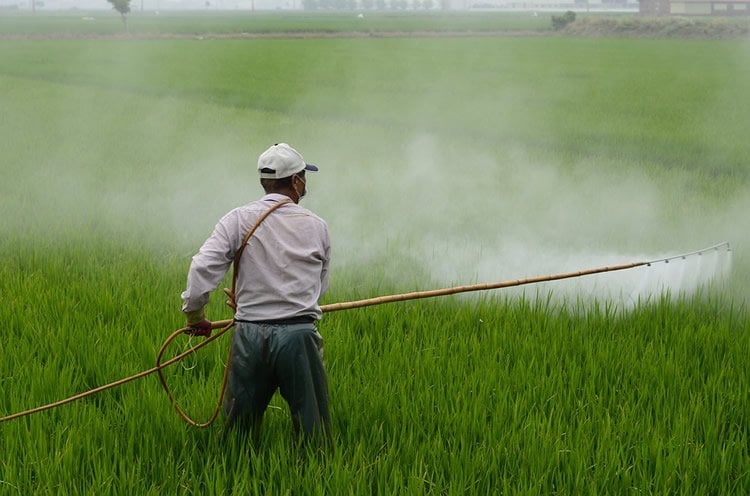Summary: People exposed to two common agrochemicals, Paraquat and Maneb, are at a 250% higher risk of developing Parkinson’s disease, researchers report.
Source: University of Guelph.
A new University of Guelph study has discovered why exposure to pesticides increases some people’s risk of developing Parkinson’s disease.
Previous studies have found an association between two commonly used agrochemicals (paraquat and maneb) and Parkinson’s disease.
Now U of G professor Scott Ryan has determined that low-level exposure to the pesticides disrupts cells in a way that mimics the effects of mutations known to cause Parkinson’s disease.
Adding the effects of the chemicals to a predisposition for Parkinson’s disease drastically increases the risk of disease onset, said Ryan.
“People exposed to these chemicals are at about a 250-percent higher risk of developing Parkinson’s disease than the rest of the population,” said Ryan, a professor in the Department of Molecular and Cellular Biology.
“We wanted to investigate what is happening in this susceptible population that results in some people developing the disease.”
Used on a variety of Canadian crops, paraquat is used on crops as they grow and maneb prevents post-harvest spoiling.
Published in the journal Federation of American Societies for Experimental Biology, this study used stem cells from people with Parkinson’s disease that had a mutation in a gene called synuclein that is highly associated with increased risk of Parkinson’s Disease, as well as normal embryonic stem cells in which, the risk associated mutation was introduced by gene editing.
“Until now, the link between pesticides and Parkinson’s disease was based primarily on animal studies as well as epidemiological research that demonstrated an increased risk among farmers and others exposed to agricultural chemicals,” said Ryan. “We are one of the first to investigate what is happening inside human cells.”
From the two types of stem cells, Ryan and his team made dopamine-producing neurons — the specific neurons affected in Parkinson’s disease — and exposed them to the two agrochemicals.
In exposing cells to agrochemicals, energy-producing mitochondria were prevented from moving to where they were needed inside the cell, depleting the neurons of energy.

Neurons from the Parkinson’s patients and those in which the genetic risk factor was introduced were impaired at doses below the EPA reported lowest observed effect level. Higher doses are needed to impair function in normal neurons.
“People with a predisposition for Parkinson’s disease are more affected by these low level exposures to agrochemicals and therefore more likely to develop the disease,” said Ryan. “This is one of the reasons why some people living near agricultural areas are at a higher risk.”
He said the findings indicate that we need to reassess current acceptable levels for these two agrochemicals.
“This study shows that everyone is not equal, and these safety standards need to be updated in order to protect those who are more susceptible and may not even know it.”
Source: Prof. Scott Ryan – University of Guelph
Publisher: Organized by NeuroscienceNews.com.
Image Source: NeuroscienceNews.com image is in the public domain.
Original Research: Abstract for “Nitration of microtubules blocks axonal mitochondrial transport in a human pluripotent stem cell model of Parkinson’s disease” by Morgan G. Stykel, Kayla Humphries, Mathew P. Kirby, Chris Czaniecki, Tinya Wang, Tammy Ryan, Vladimir Bamm, and Scott D. Ryan in FASEB Journal. Published April 24 2018
doi:10.1096/fj.201700759RR
[cbtabs][cbtab title=”MLA”]University of Guelph “Study Reveals Cause of Pesticide Exposure and Parkinson’s Link.” NeuroscienceNews. NeuroscienceNews, 23 May 2018.
<https://neurosciencenews.com/pesticide-parkinsons-9123/>.[/cbtab][cbtab title=”APA”]University of Guelph (2018, May 23). Study Reveals Cause of Pesticide Exposure and Parkinson’s Link. NeuroscienceNews. Retrieved May 23, 2018 from https://neurosciencenews.com/pesticide-parkinsons-9123/[/cbtab][cbtab title=”Chicago”]University of Guelph “Study Reveals Cause of Pesticide Exposure and Parkinson’s Link.” https://neurosciencenews.com/pesticide-parkinsons-9123/ (accessed May 23, 2018).[/cbtab][/cbtabs]
Abstract
Nitration of microtubules blocks axonal mitochondrial transport in a human pluripotent stem cell model of Parkinson’s disease
Neuronal loss in Parkinson’s disease (PD) is associated with aberrant mitochondrial function in dopaminergic (DA) neurons of the substantia nigra pars compacta. An association has been reported between PD onset and exposure to mitochondrial toxins, including the agrochemicals paraquat (PQ), maneb (MB), and rotenone (Rot). Here, with the use of a patient-derived stem cell model of PD, allowing comparison of DA neurons harboring a mutation in the α-synuclein (α-syn) gene (SNCA-A53T) against isogenic, mutation-corrected controls, we describe a novel mechanism whereby NO, generated from SNCA-A53T mutant neurons exposed to Rot or PQ/MB, inhibits anterograde mitochondrial transport through nitration of α-tubulin (α-Tub). Nitration of α-Tub inhibited the association of both α-syn and the mitochondrial motor protein kinesin 5B with the microtubules, arresting anterograde transport. This was, in part, a result of nitration of α-Tub in the C-terminal domain. These effects were rescued by inhibiting NO synthesis with the NOS inhibitor Nω-nitro-L-arginine methyl ester. Collectively, our results are the first to demonstrate a gene by environment interaction in PD, whereby agrochemical exposure selectively triggers a deficit in mitochondrial transport by nitrating the microtubules in neurons harboring the SNCA-A53T mutation.






